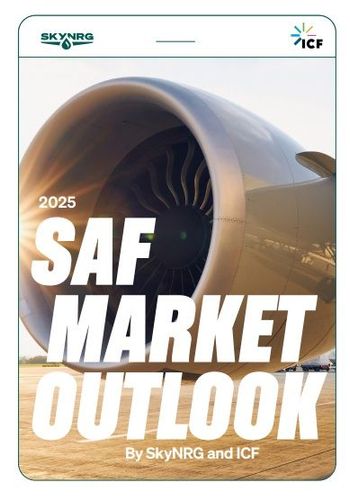SkyNRG, ICF release 2025 SAF outlook

SOURCE: SkyNRG
June 10, 2025
BY Erin Krueger
SkyNRG on June 5 released its fifth Sustainable Aviation Fuel Market Outlook. The report, developed in collaboration with ICF, highlights the need to scale up technologies and feedstocks that are an alternative to hydroprocessed esters and fatty acids (HEFA) fuels.
The report predicts that global sustainable aviation fuel (SAF) demand will reach 2 million metric tons this year, supported by new SAF mandates in the European Union and U.K. SAF demand could increase to more than 15 million metric tons by 2030 and 40 million metric tons (13.2 billion gallons) by 2035, according to the report.
Advertisement
Globally, approximately 82% of all announced SAF capacity up to 2030 is expected to utilize HEFA technology. According to the report, reliance on HEFA technology could restrict growth in the SAF industry due to limited availability of feedstock.
In the U.S., SAF demand is expected to be shaped by a complex mix of federal policies, state-level fuel standards, financial incentives and voluntary demand. The report predicts U.S. SAF demand will range between 1.7 billion gallons and 3 billion gallons by 2030, depending on how federal- and state-level policies evolve.
Advertisement
U.S. SAF production capacity is currently expected to reach 1.9 billion gallons per year by 2030, with 61% of announced projects expected to utilize HEFA technology and 24% of announced projects expected to utilize ethanol-to-jet technology.
The report also addresses the potential for SAF production across the rest of the globe, with SAF capacity in the European Union and U.K.; Asia; and the rest of the world expected to reach 1.3 billion gallons, 1.9 billion gallons, and 1 billion gallons, respectively, by 2030.
A full copy of the report is available on the SkyNRG website.
Related Stories
The USDA significantly increased its estimate for 2025-’26 soybean oil use in biofuel production in its latest World Agricultural Supply and Demand Estimates report, released July 11. The outlook for soybean production was revised down.
The U.S. Energy Information Administration maintained its forecast for 2025 and 2026 biodiesel, renewable diesel and sustainable aviation fuel (SAF) production in its latest Short-Term Energy Outlook, released July 8.
XCF Global Inc. on July 10 shared its strategic plan to invest close to $1 billion in developing a network of SAF production facilities, expanding its U.S. footprint, and advancing its international growth strategy.
U.S. fuel ethanol capacity fell slightly in April, while biodiesel and renewable diesel capacity held steady, according to data released by the U.S. EIA on June 30. Feedstock consumption was down when compared to the previous month.
XCF Global Inc. on July 8 provided a production update on its flagship New Rise Reno facility, underscoring that the plant has successfully produced SAF, renewable diesel, and renewable naphtha during its initial ramp-up.
Upcoming Events










